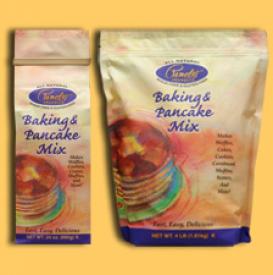TOUCHED BY LYME: Gluten-free eating hits the mainstream

Many folks with Lyme find they do better if they avoid gluten-containing foods (wheat, barley, rye). As the ranks of people avoiding gluten rises, food manufacturers are starting to take notice. Yet switching to gluten-free eating can still be a challenge. Here are some tips.
If you’re in a room with a lot of people with Lyme disease, chances are good that many of them follow a gluten-free diet. Some may be officially diagnosed with celiac, a severe intolerance to the gluten found in wheat, barley and rye. Others may simply have found through trial and error that they feel better when they avoid gluten-containing foods.
It’s a club more and more people are joining daily (not just those with Lyme disease) and food manufacturers are taking notice. Rice Chex recently removed some offending ingredients to become gluten-free, and even Betty Crocker has a gluten-free cake mix on the shelf.
Yet, even with more GF products available, it can still be jarring to switch to a GF diet. Especially if you don’t want to be a short-order cook for different dietary needs in the family. Here’s my advice to anyone starting down the gluten-free road.
Recognize that food fulfills an emotional need as well as a physical one. Find ways not to feel deprived. My family really likes pancakes on Saturday mornings and pasta for dinner. Yet, the GF substitutes we tried at first didn’t appeal to any of us. We feared we’d have to give up pancakes and noodle dishes forever.
Then we found Pamela’s baking mix. Pancakes made from Pamela’s are simply divine, and none of us would go back to the old ones even if we could. The company has a whole line of excellent GF products.
Next we found Tinkyada noodles. We think they are head and shoulders above other rice noodles we tried. We often serve them to dinner guests without pointing out that they are gluten-free. No one notices. They just help themselves to seconds.
If you’re going to give GF a try, read up on it so you know what you’re doing. (The Celiac Disease Foundation website and The Gluten-Free Bible are good places to start.) It’s important to know the hidden sources of gluten. Did you know soy sauce usually has wheat in it? For someone with acute sensitivity, even a drop can be severely debilitating.)
Find a good source of gluten-free groceries. Whole Foods Market carries its own line of GF baked goods, as well as many other GF items. If you happen to be near Sacramento, California, you can visit the Gluten Free Specialty Market, where every item in the store is gluten-free. Health food stores and on-line vendors are other options.
Learn how to prepare GF food yourself. I’m anxiously awaiting a book due out this fall called Make it Fast, Cook it Slow. It’s gluten-free recipes for the crock pot! The author also maintains a blog with gluten-free crockpot recipes, which can tide you over til the book comes out.
You can contact this blogger at dleland@lymedisease.org.




















This is a great article
I've found the most fun way for me to do without gluten has been to learn to cook with organic whole grain millet, amaranth, buckwheat and quinoa. There are lots of recipes — from sprouting techniques to internationally flavored dishes — and there's just plain experimenting with your own favorite spices! Besides, I have to avoid the packaged and pre-made "gluten free" fair because most of it has ingredients I am allergic to, or additives that really aren't good for anybody.
Learn about diet and Lyme disease including the effects of gluten. Lyme disease diet articles – http://www.lyme-disease-research-database.com/lyme_disease_blog_files/category-diet-and-lyme-disease.html